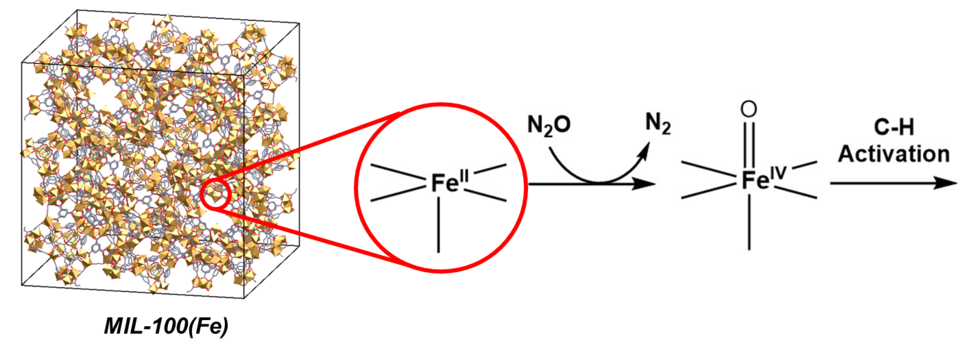Light alkane oxidation of Fe(II) sites in metal–organic framework nodes

Metal Organic Frameworks (MOFs) with controlled nuclearity and porosity have the potential for use as biomimetic catalysts engendering the activation of light alkanes, opening new pathways for the enhancement of underutilized chemical feedstocks. In a highly collaborative work among the Department of Chemistry and the Department of Chemical Engineering and Materials Science at the University of Minnesota, alongside colleagues at the University of California Davis, Stanford Synchrotron Radiation Lightsource (SSRL), and Stony Brook University, researchers were able to report the activation of C2 and C3 alkanes over well-defined, mononuclear iron sites situated within the nodes of a MOF that bear similar nuclearity, oxidation state (+2), and spin state (S=2) to iron centers in certain enzymes that activate alkanes oxidatively. This study was reported in the Journal of the American Chemical Society (DOI: 10.1021/jacs.9b08686).
Changes in iron coordination and oxidation were measured using X-ray absorption spectroscopy (XAS), Mössbauer spectroscopy, and pair distribution function (PDF) analysis, and combined with probe molecule infra-red spectroscopy and in-situ chemical titrations to identify a biomimetic Fe(II) specie as the active site and enumerate site densities. The reaction kinetics and mechanism were deduced by varying reactant concentration, temperature, and batch time, confirming accompanying density functional theory calculations that computed a complete catalytic cycle. Further calculations implicated secondary metal atoms in proximity to the active Fe(II) site being able to impart changes in the reaction barrier of the rate-limiting step, opening new opportunities for synthesizing materials designed to tune the reactivity towards certain reaction pathways.
Experiments characterizing the bulk structure of the MOF and its reactivity were performed by Matthew Simons, a graduate student co-advised with Professor Aditya Bhan and Professor Laura Gagliardi. Jenny Vitillo, Ph.D., a post-doctoral research associate with Professor Gagliardi and Professor Connie Lu, performed the synthesis and quantum mechanical characterization of the material. In-situ XAS experiments were performed at SSRL in collaboration with the groups of Professor Bruce Gates and Simon Bare, Ph.D. Data for PDF analysis was collected at Argonne National Laboratory by Professor Karena Chapman’s group. This work was supported by the Inorganometallic Catalyst Design Center—an Energy Frontier Research Center based in the Department of Chemistry at the University of Minnesota.